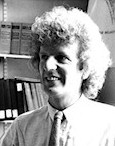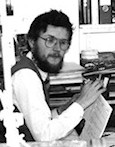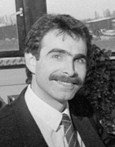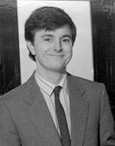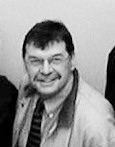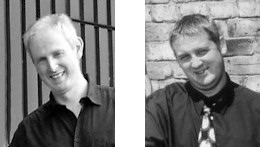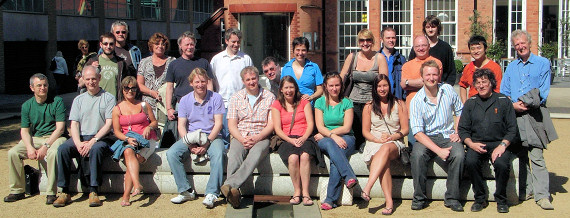Ainsley Gommon Architects have quite a few members of staff who are budding amateur photographers, filling their spare time undertaking courses, entering competitions and generally getting out and about with their cameras. One issue of the Chester Chronicle ‘Reader’s Photos’ page in May featured photographs by two Ainsley Gommon members of staff side by side! See below for a copy of the newspaper with the photographs by Alf Plant (Campion Flowers 2) and Sarah Davies (Pretty in Pink).
Liverpool Habitat for Humanity appears in the local press
Our project with Habitat for Humanity in Liverpool has appeared in the local press after a new Partnership with Cosmopolitan Housing Association has secured the construction of the remaining 23 new homes in Toxteth. Nine of the low cost homes have already been completed and were built almost entirely by volunteers. The article follows new resident Hlonipani Ben Mpotu’s story after he invested 500 hours of volunteer labour in lieu of a £10,000 deposit on his new family home.
Click on the image above to read the article or to see more information about the project go to our webpage: Habitat for Humanity
11/06/2012
Ainsley Gommon Architects; how it all began
As it has been a while since we started the account of the first 30 years of Ainsley Gommon, we have re-posted the earlier episodes here, so our readers can follow the whole story from the beginning. Here’s where it all began……..
The Partnership, originally created in 1979 brought together three Liverpool Graduates who wished to practice together, pooling resources, and working with client groups that they found interesting. They were acquaintances more than friends, and in fact David Ainsley and Peter Gommon had rarely crossed each others paths before joining the partnership. We would be characterised as:-
‘The entrepreneur’ – David Innes Wilkin
He started it all, and had always had that particular confidence that you need to go it alone, and back your own ideas. From a schoolboy and undergraduate he had always had an eye for a “good wheeze”. He had worked for private practice, Runcorn Development Corporation and in Partnership with a graphics consultancy.
Attitude: If you saw £50 lying on a coffee table, you’d bend down and pick it up.
Experience: Principally housing and interiors.
He knew what accounts looked like.
‘The Professional’ – David Ainsley
Second to join, and an early escapee from Local Authority life, where he had worked for the City of Liverpool and Wirral, ending up as a principal architect with a team working for him; an experience neither of the other partners had. He knew how local authority committees worked.
Attitude: Let’s do this properly, and get the details to work.
Experience: Principally Social Services with some education work as well.
He didn’t know what accounts looked like.
‘The Housing Specialist‘ – Peter Gommon
Third to join, escaping from a housing association in-house design team, he had previously worked in a private practice that specialised in cost yardstick housing, but always found working for other people – committees etc. frustrating.
Attitude: Smash the cistern, you’ve got nothing to lose but your chain.
Experience: Cumbrian rural housing, sheltered housing and new urban estates
He didn’t know what accounts looked like.
David Wilkin drove an elderly Citroen Dyane and smoked.
David Ainsley drove a more recent Renault Six and smoked.
Peter Gommon drove an elderly Triumph Herald convertible and smoked sometimes.
The partnership, Inness Wilkin Ainsley Gommon, started in a single room on the second floor of 1 Price Street, and there were the three of us with assistant Andy Mair, a Liverpool graduate and Lowestoft lad, like David Wilkin, and Diane MacDonald a part time secretary. Initially, before expanding, the practice turnover was approximately £45,000 p.a, and was to expand to £75,000 p.a when we joined together.
The practice motto, culled from a seminal work on management by Robert Townshend and originally coined for AVIS, was “we try harder“, and we had to run hard to stand still. With small resources and limited space it was not forseen that we would ever grow to a size greater than ten people; usually there were between five and eight of us.
Everyone had to act as a jack-of-all-trades since there was no back-up to help out. Everyone worked long hours, evenings and weekends too and there were plenty of hairy moments. The stress was eased by what became our Friday afternoon ritual period of relaxation spent in The Letters (the old Letters PH).
The atmosphere we created was positive, a touch of that 60’s optimism. We liked working together in a studio (big room) and felt that this was a positive way of getting other people who joined to feel part of the show. No one had any specific management training and everything was learned on the job. Our heavy involvement with the Liverpool Housing Co-operatives was an excellent character forming experience, and taught all of us a lot about our strengths and weaknesses, but also how to react to people’s needs and particularly how to organise collecting information and presenting ideas. The heavy involvement in co-ops spanned the period 1979 – 1986, and during that time we spent a lot of time working on competitions too.
David Wilkin had taken a Masters degree at the School of Civic Design, and was very aware of current thinking in Participation and Consultation coming out of the American Schools on the West Coast. When we were chosen by our first Coop, Hesketh Street, and started working with them, David had an absolutely clear idea of how to manage the process and to engage with our clients on a one to one basis. Everybody else was simply picking it up as they went along.
The Coops were the perfect client group for us; they matched the nature and style of the Practice. David Wilkin had invited David and Peter to join him on a self supporting basis, bringing work and contacts with them. Their entry was eased by a form of sweat equity in which they grew their stake in the partnership over time. Working for Co-ops allowed David Wilkin to use his knowledge and experience of participation. They were left field, as we were, and appealed to our practical approach to design, where we used the term cheap and cheerful not as a perjorative term, but to describe what we sought to achieve. By definition the houses were supposed to be cheap to build, by ingenuity we could achieve this and design them to be cheerful, and life enhancing. There was a superabundance of cheap and nasty out there, which the Coop members were trying to avoid by creating their own living environments.
The learning and sharing to gain of working directly with our Coop clients for relatively recent graduates was very much a home-from-home, a form of open university in which we all learned from each other and the contractors as they too came on board and shared in the process. While we were doing this, the office’s finances were underpinned by a steady flow of Rehabs, mostly Two-up-Two-downs in Birkenhead and in South Liverpool. This steady flow of short contracts provided a sound education in contract law, managing costs, providing clear information using word processed schedules of works and negotiating with builders. To be continued….
31/10/2011
The Ainsley Gommon story : Episode 2
This is a re-posting of part 2 of the first decade of the Ainsley Gommon story.
We wanted to be known as an approachable and friendly practice that could work within limited budgets to produce our cheap but cheerful schemes. All of us as individuals were keen to be associated with high design standards, but we were rarely able to allocate enough time at the detailed design stage to fully resolve the details of our designs, though through Andy Mair we had great expertise in hot water and heating systems.
The change in the political structure of Liverpool in 1983 almost brought the practice to a premature end by stopping almost all of the work on co-ops, and restricting the flow of housing association work to a trickle. In response we decided to diversify our workload and geographical base to improve stability; After Peter Gommon completed the Birmingham Landscape course and professional practice in 1982, we started to develop a Landscape Design workload. David Wilkin set up the Bristol Branch in 1984, moving there in the same year.
One of the reasons for examining the early history of how the practice started was to try and establish how and why decisions were made, so that we could define how the practice could develop and change without losing its spirit or character.
Originally we couldn’t imagine being in a position to employ highly qualified people because of the expense, and the volatile nature of our workload. We relied on competent year-out students and on being able to find an extra pair of hands for short periods in times of stress. This is understandable when you appreciate that we could rarely see more than eight weeks ahead on the cash flow. Partners played a significant part in producing production drawings on early schemes, and spent a lot of time on exciting two up two down rehabs and on site visits.
Gradually however, through a growing network of people who had worked in their year-outs or holidays, there came to be a pool of people who came back into the practice to become part of the family.Someone who would later play a significant part in the development of the practice entered stage left at this time. Alf Plant joined in 1982 as a year-out student bringing his special skills in precision model making and draughtsmanship, and later returned to become a core member of the family and later a director.
On the admin side we had enjoyed a prolonged period of stability, both Dorothy Lewis (1980) and Lee Robinson (1982) being part of the original team. In 1985-86 there was a shift of philosophy to a view that since people did return to the practice, and increased their skills and experience through working out of 1 Price Street, we could and should become a people based firm rather than a hire-and-fire firm. Perhaps surviving the great crash of 1983 had given us a new perspective.
Forward planning and strategy was done on an ad-hoc basis, although formally worked up through monthly partners meetings which were usually held in one of our houses. The meetings which were formal and structured were highly productive and usually lasted for three hours, towards the end dissolving into rather relaxed and emotional affairs as a result of the main-brace being spliced. The anti-intellectual tradition held sway during this period in that in spite of many efforts to put office philosophy and aims and objectives on the agenda these concepts were usually discussed post the euphoric stage and as a result didn’t get minuted. However the principle that developed through these meetings was that we would try to retain people who wanted to grow with the firm.
David Wood had joined us in his holidays and returned to Birkenhead after graduating from the Edinburgh school. When he said he wanted to move away from the region and make it in the Big Smoke we discussed the funding of a new office, to be worked up in principle in the same way as Bristol.
David could be characterised as “The Go Getter”, he had toured the States in his year out, and drunk deep from the cup of post modernism. He wanted to work with more commercial clients than our established housing clients, and to experience the cut and thrust of real competition.
Attitude; “Let’s go” and “phew”-usually expressed after a hairy moment.
Experience:- Rehabs for Family Housing, private houses for eccentric individuals and setting out drawings for asymmetrical free-form layouts (Shorefields).
The idea of a London base appealed to the original partners, not because of any sense of self importance, but simply because so much work originated in the capital, and there were natural linkages between London and Bristol. At the time Bristol was working for a client in London-Camden Graphics.
The cost of paying for these expansions had been borne by the Birkenhead Office which fortunately had experienced a period with a stable workload. Through much burning the midnight oil and some very productive workers, the office had remained profitable. The reason for this was two very important projects, the Enveloping of Goodwin Avenue and Mason Avenues for Wirral Borough Council which were our first truly large commissions with a finite input for a finite reward. By comparison with the open ended co-operative schemes these were ‘proper” jobs. They also meant that everyone in the office participated at some stage in putting together elements of the schemes. They had a unifying effect on working practice after many years of each of us flying our own kites (and also at times flying by the seat of our trousers).
In 1985 Simon Venables joined us in Birkenhead. Simon would later be responsible for growing the practice into the far reaches of Wales and brought with him different skills from a health and specialist needs background. Like the originating Partners, Simon was ‘people focussed’ and believed in the same ethic that as designers we are accountable to our clients and end users and should always ‘go that extra mile’.
Attitude: “Keep smiling and be positive …a little hard work never hurt anyone”
Experience: Hospitals and health care facilities for people with dementia, sheltered housing.
With two fledgling offices to feed Birkenhead needed to be profitable and it needed to know that its offspring would quickly become self supporting. The Bristol office in spite of generating a perfectly respectable turnover and carrying out the practice’s biggest ever project-the Airbus wing factory in Bristol- failed to generate a profit during the first three years. It was during this period that significant differences in approach and philosophy emerged, which lead to the split of with David Wilkin 1988 and the formation of Ainsley Gommon Wood. During the period of 1986 – 1988 the increased size and complexity of the practice had seen the creation of Associates Garry Usherwood and Simon Venables.
With Garry came the introduction of computers for draughting while Simon helped lead the push into new areas involving health care and special needs. Peter and David developed our urban design and master-planning capabilities while Alf promoted our conservation and restoration skills. They were heady times with our experience and knowledge base growing rapidly.
The opening of the North Wales Office in 1988 was a further initiative intended to allow us to work in Wales, building off existing contacts and work in the North West. It has often been suggested that Peter and David were looking for somewhere to keep their tiny flock of Lleyn sheep that led to this move, while David had bought a small farmhouse in Llanrhaeadr.
However, it was here in Wales that our existing housing association and local authority client base could be further developed. Simon set up the office, initially on Deeside Industrial Park in a Welsh Development Agency starter unit, assisted by Mark French, Mike Jones and landscape architect Vicky McCombie.
Mark would later take a major role in developing the Wales offices and brought with him his health care experience, professional skills and prudence. Some of the early jobs in Wales were quite bizarre. The feasibility design for an Hydrographic Centre in Iraq, being one of a number of curious projects for which we never got paid. Having escaped a meeting with the Iraqi Navy as the political tide changed, we thankfully won the Eisteddfod Architecture prize in 1988 for a boat museum in Newport that featured in the Architects Journal. The £750 prize money helped us pay off our overdraft bank charges and gave us a welcome boost.
Although we were bracing ourselves for the recession that followed in the early nineties, the Wales office was successfully launched and we were coping quite well. Despite the growing bank overdraft, we tried not to think too much about the financial risks we were taking. Nevertheless with London thriving and both Birkenhead and Wales working closely together, the late 1980’s and early 1990’s were a time to feel optimistic, as we were growing our collective experience and the services we could offer our clients.
Computers enabled David Ainsley to do cash flows which could respond easily to changed circumstances, and which could predict downturns rather than them coming as a nasty shock. Curiously, by having this extra information, our bank manager became more nosey about what was going on, rather than being reassured by greater transparency. From the very beginning we had consistently won awards for our work which had reinforced our position as a practice that took design seriously. We had become of necessity much better organised in the running of our affairs, but we still lacked a coherent framework and team structure to base long term decisions on. The split-up and reformation of the partnership had lead to too many hours spent closeted in smoke filled rooms, in marked contrast to our ideal of sharing an open office with the whole team.
By the end of the first decade we stood on the threshold of a new and exciting period of consolidation and growth in which we endeavoured to involve everyone who was working at AGWA in the process, based on two key principles. Firstly that it is impossible in commercial life to stand still; you either expand or contract. We didn’t want to contract, so we therefore had to continue to grow. We had learned that expansion from within using home-grown talent was the surest and most rewarding way to do this and could enable our practice to maintain the identity that had formed part of the original DNA and had been retained and strengthened during our first ten years.
Team members who played a significant role in this first decade included Ben Downey, an architect’s son from Essex who trained at Liverpool School of Architecture. Ben had worked for his father, and had a firm grasp of what an architect was meant to do. At the same time Alf Plant had returned from University after completing his degree, and was busy refurbishing large Victorian houses into flats, as well as making superlative models. Paul Lester joined the practice straight from school, and although no one knew it at the time, was on the launch pad of a career that would see him become a director of the practice.
31/10/2011
The Ainsley Gommon Story – The Second Decade
The broad body of work that had been undertaken in the first decade removed the awkward question, have you done this before? We were able to compete on equal terms with larger practices, and where the brief demanded consultation with the end-user we had a strong advantage. CAD replaced drawing as the principle method of producing information, and the size of the projects increased exponentially, as did the scope of consultation. The office in Wales worked closely with the Birkenhead office in our first major project in South Wales – Glyntaff, in 1988, where our first project office opened on the estate. The stock transfer and redevelopment of the Glyntaff Farm Estate provided work for the practice over the next twelve years, working closely with the residents and furthering the consultation skills learnt working with the Liverpool Housing Co-ops in the early days.
 Masterplanning, tenant participation, new build and refurbishment at the Glyntaff Farm Estate
Masterplanning, tenant participation, new build and refurbishment at the Glyntaff Farm Estate
Towards the end of the decade the London office separated from the practice, but new work for Torfaen County Borough led to the opening in 1998 of a full time South Wales office on the Fairwater III estate in Cwmbran.
Appointments were still won through competition, and opportunities remained for building long term relationships with clients based on the quality of service we provided. During this period, a number of key members of staff joined the Practice, including Steve Geary, an Architectural Technologist who joined the Birkenhead office,who would later go on to become a Director.
Building Surveyor Hywel Jones joined to manage the South Wales office and the North Wales office expanded with Architect Neil McGill and Architectural Technician Maurice Garnett joining the team, both of whom would later go on to become Associates.
Mindful of the need to demonstrate that we managed our projects well, we gained Quality Assurance accreditation to ISO 9001 through a period of training and development, and with our involvement with Willmott Dixon, we became pioneers in Partnering for Procurement both in Wales and England.
Eight new awards, including the significant RIBA sponsored Chavasse Park Competition 1st Prize-now Liverpool One-win and an RIBA Welsh Housing Design Award for new homes at Glyntaff continued the culture of aiming high.
 Chavasse Park, winner of a National RIBA Competition to redevelop Central Liverpool
Chavasse Park, winner of a National RIBA Competition to redevelop Central Liverpool
Significant projects during our second decade 1990-1999 included:
Hulme 3-Phase One Master-plan and New Housing; Glyntaff Farm Phases 1-8 Master-plan; Estate Refurbishment and New Housing; The Antiques Triangle Restoration and Refurbishment; Waterloo Buildings Restoration and Refurbishment; The Willowbrook Hospice; Hope House Hospice; Prestatyn High School Library, Maths Building and Remodelling; Buildings and Landscapes for Merseyside Development Corporation; Brunswick Harbour Commercial Housing Development; Bromborough Pool Village Hall and Master-plan; Fairwater III Estate Master-plan and Refurbishment, Cwmbran; Ashworth Hospital Landscape Strategy; Larks Wood New Road Housing in Waltham Forest and Garden City Estate Remodelling Deeside.
31/10/2011
The Ainsley Gommon Story – The Third Decade
Following a bit of a break, here is the final instalment in the story of the first 30 years of Ainsley Gommon Architects. We will follow this by publishing the second decade and then re-post the earlier episodes and once this is done, readers can read the whole story chronologically (if you see what we mean!).
The the third decade of Ainsley Gommon began in 2000 and, thinking about how the practice and its people would continue to develop in the new millennium, we decided to become a Limited Company in 2001. Partners became Directors and Associates became part of the long term planning for succession that would underpin the practice in future.
During this period the Practice expanded, and included the addition to the Birkenhead Office of Maria Killick, an Architect who would later go on to become a Director.
In 2001, our South Wales project office moved from Cwmbran to open a permanent office in Newport, South Wales to better support the considerable workload in the area, which included the redevelopment of seven estates of obsolete prefabs for Newport Housing Trust. The £38 million scheme provided 550 new bungalows in a six year programme and built upon the community consultation skills the practice has become renowned for, making sure that every resident was consulted by the designers and the development team.
Competition for work moved into a new phase; increasingly work had to be bid for through the European Journal process, resulting in our working for a number of framework partners. We continued to consolidate our professional standing as an RIBA Chartered Practice, Registered Landscape Practice and in 2005 we gained the Investors in People standard, in recognition of our commitment to the personal development of our people and their contribution to the well-being of the practice. Always adding new skills and services, two of our team qualified as Planning Supervisors (later becoming CDM Coordinators).
The scope of work continued to extend, with Education, Health, Leisure and Master-planning projects, as well as significant Housing projects, which continued to underpin our workload across the North West of England and throughout Wales.
Birkenhead Park Pavilion, including a Visitor Centre, Cafe and Offices completed in 2005
Sound environmental practice has always been at the heart of what we do and in 2007 we started on the path to formal recognition of our Environmental Management System, initially through the BS8555 ‘Acorn’ scheme, and gained UKAS accredited registration to ISO14001 in February 2009 – making us one of the first architects’ practices to achieve this in our regions.
Ainsley Gommon have always acknowledged that planning and design of the built environment has a significant impact on resource use and pollution at global and local levels and is therefore critical in moving towards a sustainable future. In the last decade this has been increasingly recognised by governments and clients and the practice has been well to deliver buildings and places to meet the new and improving measures of environmental performance.
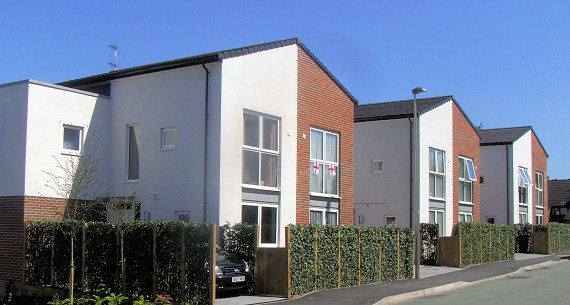 New homes at Maplewood, Macclesfield meeting Code for Sustainable Homes Level 3
New homes at Maplewood, Macclesfield meeting Code for Sustainable Homes Level 3
Nineteen design awards have made the most recent decade one of our most productive, with two significant awards for Drybridge Gardens, the RSAW Housing Design award, and a Civic Trust mention.
 Drybridge Gardens, award winning Particular Needs Accommodation in Monmouth
Drybridge Gardens, award winning Particular Needs Accommodation in Monmouth
In November 2009 we celebrated 30 years in practice with an exhibition titled ‘People+Place’, which launched in Liverpool and was later shown in Cardiff, Newport, Birkenhead and Harrogate.
 The Ainsley Gommon team in November 2009 at the launch of our ‘People & Place’ exhibition
The Ainsley Gommon team in November 2009 at the launch of our ‘People & Place’ exhibition
As the decade drew to a close, our very first retirements occurred in 2009, with founder of the Practice David Ainsley retiring first, followed by co-founder Peter Gommon in 2010. Following our succession plan, Director’s Alf Plant, Simon Venables and Mark French were joined by newly appointed Director’s Paul Lester, Steve Geary and Maria Killick to become the new management team.
 Alf Plant, Simon Venables, Mark French, Paul Lester, Steve Geary and Maria Killick
Alf Plant, Simon Venables, Mark French, Paul Lester, Steve Geary and Maria Killick
With the new Directors now firmly in place, we feel well set for the next three decades.
Significant Projects in our third decade 2000 to 2010 included:
The Newport Prefabs and Bungalow Replacements, Drybridge Gardens Particular Needs Housing, The Birkenhead Park Pavilion, Birkenhead YMCA, Swansea University Projects and Mall Landscape, Deeside College Educational Buildings, Key Worker Housing Projects in Chester and Birkenhead, Extra Care Housing Projects for Older People in North and South Wales, Remodelling of Historic Buildings at Plas Gwenfrewi Holywell, Riverside Housing Redevelopment Pontypool, Liverpool Habitat for Humanity Self-build Housing, Creative Re-use of Cambrian Railway Works as a Primary Care Centre, New Police Station in Bangor, Lower Broughton Master-plan and Landscape, Raffles Vision Estate Renewal, Alway Estate Regeneration in Newport, and Birkenhead Triangles Urban Regeneration.
31/10/2011
Tales of Future Past
Sorry it’s been a while since the last instalment of the Ainsley Gommon story, but we have now completed our look back over our first 30 years in practice and we are ready to publish the second and third decades of our story. We will then repost the earlier instalments, so that those who wish to can read the whole story chronologically.
Following completing this retrospective, we plan to use the blog to let you know what we are doing now, looking forward to the future and other musings, which we hope will be of interest.
31/10/2011
The Ainsley Gommon story : Episode 2
 We wanted to be known as an approachable and friendly practice that could work within limited budgets to produce our cheap but cheerful schemes. All of us as individuals were keen to be associated with high design standards, but we were rarely able to allocate enough time at the detailed design stage to fully resolve the details of our designs, though through Andy Mair we had great expertise in hot water and heating systems.
We wanted to be known as an approachable and friendly practice that could work within limited budgets to produce our cheap but cheerful schemes. All of us as individuals were keen to be associated with high design standards, but we were rarely able to allocate enough time at the detailed design stage to fully resolve the details of our designs, though through Andy Mair we had great expertise in hot water and heating systems.
The change in the political structure of Liverpool in 1983 almost brought the practice to a premature end by stopping almost all of the work on co-ops, and restricting the flow of housing association work to a trickle. In response we decided to diversify our workload and geographical base to improve stability; After Peter Gommon completed the Birmingham Landscape course and professional practice in 1982, we started to develop a Landscape Design workload. David Wilkin set up the Bristol Branch in 1984, moving there in the same year.
One of the reasons for examining the early history of how the practice started was to try and establish how and why decisions were made, so that we could define how the practice could develop and change without losing its spirit or character.
Originally we couldn’t imagine being in a position to employ highly qualified people because of the expense, and the volatile nature of our workload. We relied on competent year-out students and on being able to find an extra pair of hands for short periods in times of stress. This is understandable when you appreciate that we could rarely see more than eight weeks ahead on the cash flow. Partners played a significant part in producing production drawings on early schemes, and spent a lot of time on exciting two up two down rehabs and on site visits.
Gradually however, through a growing network of people who had worked in their year-outs or holidays, there came to be a pool of people who came back into the practice to become part of the family.Someone who would later play a significant part in the development of the practice entered stage left at this time. Alf Plant joined in 1982 as a year-out student bringing his special skills in precision model making and draughtsmanship, and later returned to become a core member of the family and later a director.
On the admin side we had enjoyed a prolonged period of stability, both Dorothy Lewis (1980) and Lee Robinson (1982) being part of the original team. In 1985-86 there was a shift of philosophy to a view that since people did return to the practice, and increased their skills and experience through working out of 1 Price Street, we could and should become a people based firm rather than a hire-and-fire firm. Perhaps surviving the great crash of 1983 had given us a new perspective.
Forward planning and strategy was done on an ad-hoc basis, although formally worked up through monthly partners meetings which were usually held in one of our houses. The meetings which were formal and structured were highly productive and usually lasted for three hours, towards the end dissolving into rather relaxed and emotional affairs as a result of the main-brace being spliced. The anti-intellectual tradition held sway during this period in that in spite of many efforts to put office philosophy and aims and objectives on the agenda these concepts were usually discussed post the euphoric stage and as a result didn’t get minuted. However the principle that developed through these meetings was that we would try to retain people who wanted to grow with the firm.
David Wood had joined us in his holidays and returned to Birkenhead after graduating from the Edinburgh school. When he said he wanted to move away from the region and make it in the Big Smoke we discussed the funding of a new office, to be worked up in principle in the same way as Bristol.
David could be characterised as “The Go Getter”, he had toured the States in his year out, and drunk deep from the cup of post modernism. He wanted to work with more commercial clients than our established housing clients, and to experience the cut and thrust of real competition.
Attitude; “Let’s go” and “phew”-usually expressed after a hairy moment.
Experience:- Rehabs for Family Housing, private houses for eccentric individuals and setting out drawings for asymmetrical free-form layouts (Shorefields).
The idea of a London base appealed to the original partners, not because of any sense of self importance, but simply because so much work originated in the capital, and there were natural linkages between London and Bristol. At the time Bristol was working for a client in London-Camden Graphics.
The cost of paying for these expansions had been borne by the Birkenhead Office which fortunately had experienced a period with a stable workload. Through much burning the midnight oil and some very productive workers, the office had remained profitable. The reason for this was two very important projects, the Enveloping of Goodwin Avenue and Mason Avenues for Wirral Borough Council which were our first truly large commissions with a finite input for a finite reward. By comparison with the open ended co-operative schemes these were ‘proper” jobs. They also meant that everyone in the office participated at some stage in putting together elements of the schemes. They had a unifying effect on working practice after many years of each of us flying our own kites (and also at times flying by the seat of our trousers).
In 1985 Simon Venables joined us in Birkenhead. Simon would later be responsible for growing the practice into the far reaches of Wales and brought with him different skills from a health and specialist needs background. Like the originating Partners, Simon was ‘people focussed’ and believed in the same ethic that as designers we are accountable to our clients and end users and should always ‘go that extra mile’.
Attitude: “Keep smiling and be positive …a little hard work never hurt anyone”
Experience: Hospitals and health care facilities for people with dementia, sheltered housing.
With two fledgling offices to feed Birkenhead needed to be profitable and it needed to know that its offspring would quickly become self supporting. The Bristol office in spite of generating a perfectly respectable turnover and carrying out the practice’s biggest ever project-the Airbus wing factory in Bristol- failed to generate a profit during the first three years. It was during this period that significant differences in approach and philosophy emerged, which lead to the split of with David Wilkin 1988 and the formation of Ainsley Gommon Wood. During the period of 1986 – 1988 the increased size and complexity of the practice had seen the creation of Associates Garry Usherwood and Simon Venables.
With Garry came the introduction of computers for draughting while Simon helped lead the push into new areas involving health care and special needs. Peter and David developed our urban design and master-planning capabilities while Alf promoted our conservation and restoration skills. They were heady times with our experience and knowledge base growing rapidly.
The opening of the North Wales Office in 1988 was a further initiative intended to allow us to work in Wales, building off existing contacts and work in the North West. It has often been suggested that Peter and David were looking for somewhere to keep their tiny flock of Lleyn sheep that led to this move, while David had bought a small farmhouse in Llanrhaeadr.
However, it was here in Wales that our existing housing association and local authority client base could be further developed. Simon set up the office, initially on Deeside Industrial Park in a Welsh Development Agency starter unit, assisted by Mark French, Mike Jones and landscape architect Vicky McCombie.
Mark would later take a major role in developing the Wales offices and brought with him his health care experience, professional skills and prudence. Some of the early jobs in Wales were quite bizarre. The feasibility design for an Hydrographic Centre in Iraq, being one of a number of curious projects for which we never got paid. Having escaped a meeting with the Iraqi Navy as the political tide changed, we thankfully won the Eisteddfod Architecture prize in 1988 for a boat museum in Newport that featured in the Architects Journal. The £750 prize money helped us pay off our overdraft bank charges and gave us a welcome boost.
Although we were bracing ourselves for the recession that followed in the early nineties, the Wales office was successfully launched and we were coping quite well. Despite the growing bank overdraft, we tried not to think too much about the financial risks we were taking. Nevertheless with London thriving and both Birkenhead and Wales working closely together, the late 1980’s and early 1990’s were a time to feel optimistic, as we were growing our collective experience and the services we could offer our clients.
Computers enabled David Ainsley to do cash flows which could respond easily to changed circumstances, and which could predict downturns rather than them coming as a nasty shock. Curiously, by having this extra information, our bank manager became more nosey about what was going on, rather than being reassured by greater transparency. From the very beginning we had consistently won awards for our work which had reinforced our position as a practice that took design seriously. We had become of necessity much better organised in the running of our affairs, but we still lacked a coherent framework and team structure to base long term decisions on. The split-up and reformation of the partnership had lead to too many hours spent closeted in smoke filled rooms, in marked contrast to our ideal of sharing an open office with the whole team.
By the end of the first decade we stood on the threshold of a new and exciting period of consolidation and growth in which we endeavoured to involve everyone who was working at AGWA in the process, based on two key principles. Firstly that it is impossible in commercial life to stand still; you either expand or contract. We didn’t want to contract, so we therefore had to continue to grow. We had learned that expansion from within using home-grown talent was the surest and most rewarding way to do this and could enable our practice to maintain the identity that had formed part of the original DNA and had been retained and strengthened during our first ten years.
Team members who played a significant role in this first decade included Ben Downey, an architect’s son from Essex who trained at Liverpool School of Architecture. Ben had worked for his father, and had a firm grasp of what an architect was meant to do. At the same time Alf Plant had returned from University after completing his degree, and was busy refurbishing large Victorian houses into flats, as well as making superlative models. Paul Lester joined the practice straight from school, and although no one knew it at the time, was on the launch pad of a career that would see him become a director of the practice.
05/11/2009
Ainsley Gommon Architects; how it all began
The Partnership, originally created in 1979 brought together three Liverpool Graduates who wished to practice together, pooling resources, and working with client groups that they found interesting. They were acquaintances more than friends, and in fact David Ainsley and Peter Gommon had rarely crossed each others paths before joining the partnership. We would be characterised as:-
‘The entrepreneur’ – David Innes Wilkin
He started it all, and had always had that particular confidence that you need to go it alone, and back your own ideas. From a schoolboy and undergraduate he had always had an eye for a “good wheeze”. He had worked for private practice, Runcorn Development Corporation and in Partnership with a graphics consultancy.
Attitude: If you saw £50 lying on a coffee table, you’d bend down and pick it up.
Experience: Principally housing and interiors.
He knew what accounts looked like.
‘The Professional’ – David Ainsley
Second to join, and an early escapee from Local Authority life, where he had worked for the City of Liverpool and Wirral, ending up as a principal architect with a team working for him; an experience neither of the other partners had. He knew how local authority committees worked.
Attitude: Let’s do this properly, and get the details to work.
Experience: Principally Social Services with some education work as well.
He didn’t know what accounts looked like.
‘The Housing Specialist‘ – Peter Gommon
Third to join, escaping from a housing association in-house design team, he had previously worked in a private practice that specialised in cost yardstick housing, but always found working for other people – committees etc. frustrating.
Attitude: Smash the cistern, you’ve got nothing to lose but your chain.
Experience: Cumbrian rural housing, sheltered housing and new urban estates
He didn’t know what accounts looked like.
David Wilkin drove an elderly Citroen Dyane and smoked.
David Ainsley drove a more recent Renault Six and smoked.
Peter Gommon drove an elderly Triumph Herald convertible and smoked sometimes.
The partnership, Inness Wilkin Ainsley Gommon, started in a single room on the second floor of 1 Price Street, and there were the three of us with assistant Andy Mair, a Liverpool graduate and Lowestoft lad, like David Wilkin, and Diane MacDonald a part time secretary. Initially, before expanding, the practice turnover was approximately £45,000 p.a, and was to expand to £75,000 p.a when we joined together.
The practice motto, culled from a seminal work on management by Robert Townshend and originally coined for AVIS, was “we try harder“, and we had to run hard to stand still. With small resources and limited space it was not forseen that we would ever grow to a size greater than ten people; usually there were between five and eight of us.
Everyone had to act as a jack-of-all-trades since there was no back-up to help out. Everyone worked long hours, evenings and weekends too and there were plenty of hairy moments. The stress was eased by what became our Friday afternoon ritual period of relaxation spent in The Letters (the old Letters PH).
The atmosphere we created was positive, a touch of that 60’s optimism. We liked working together in a studio (big room) and felt that this was a positive way of getting other people who joined to feel part of the show. No one had any specific management training and everything was learned on the job. Our heavy involvement with the Liverpool Housing Co-operatives was an excellent character forming experience, and taught all of us a lot about our strengths and weaknesses, but also how to react to people’s needs and particularly how to organise collecting information and presenting ideas. The heavy involvement in co-ops spanned the period 1979 – 1986, and during that time we spent a lot of time working on competitions too.
David Wilkin had taken a Masters degree at the School of Civic Design, and was very aware of current thinking in Participation and Consultation coming out of the American Schools on the West Coast. When we were chosen by our first Coop, Hesketh Street, and started working with them, David had an absolutely clear idea of how to manage the process and to engage with our clients on a one to one basis. Everybody else was simply picking it up as they went along.
The Coops were the perfect client group for us; they matched the nature and style of the Practice. David Wilkin had invited David and Peter to join him on a self supporting basis, bringing work and contacts with them. Their entry was eased by a form of sweat equity in which they grew their stake in the partnership over time. Working for Co-ops allowed David Wilkin to use his knowledge and experience of participation. They were left field, as we were, and appealed to our practical approach to design, where we used the term cheap and cheerful not as a perjorative term, but to describe what we sought to achieve. By definition the houses were supposed to be cheap to build, by ingenuity we could achieve this and design them to be cheerful, and life enhancing. There was a superabundance of cheap and nasty out there, which the Coop members were trying to avoid by creating their own living environments.
The learning and sharing to gain of working directly with our Coop clients for relatively recent graduates was very much a home-from-home, a form of open university in which we all learned from each other and the contractors as they too came on board and shared in the process. While we were doing this, the office’s finances were underpinned by a steady flow of Rehabs, mostly Two-up-Two-downs in Birkenhead and in South Liverpool. This steady flow of short contracts provided a sound education in contract law, managing costs, providing clear information using word processed schedules of works and negotiating with builders. To be continued….
30/10/2009
Ainsley Gommon Architects Blog
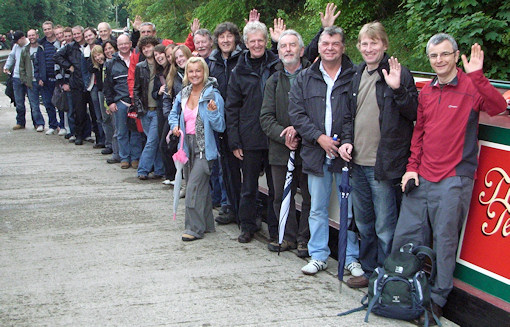
Welcome to Ainsley Gommon Architects Blog.
Ainsley Gommon Architects are celebrating 30 years in practice by holding an exhibition at ‘milkandsugar’, The Tea Factory, 82 Wood Street, Liverpool from 16 November to 23 December 2009. As we plan the exhibition we will be posting articles and pictures on this blog, which we hope will be of interest and give a foretaste of the exhibition.
06/10/2009
Older Blog Posts
- May 2015 (1)
- August 2013 (1)
- June 2013 (1)
- April 2013 (3)
- January 2013 (1)
- October 2012 (2)
- June 2012 (3)
- October 2011 (5)
- November 2009 (1)
- October 2009 (2)
AGA on twitter
Tweets by AGArchitectsRecent Flickr Photos
Authors
-
Ainsley Gommon
-
Mark French
mcevoyt
-
Peter Gommon
plester2012
-
Sarah Davies
-



